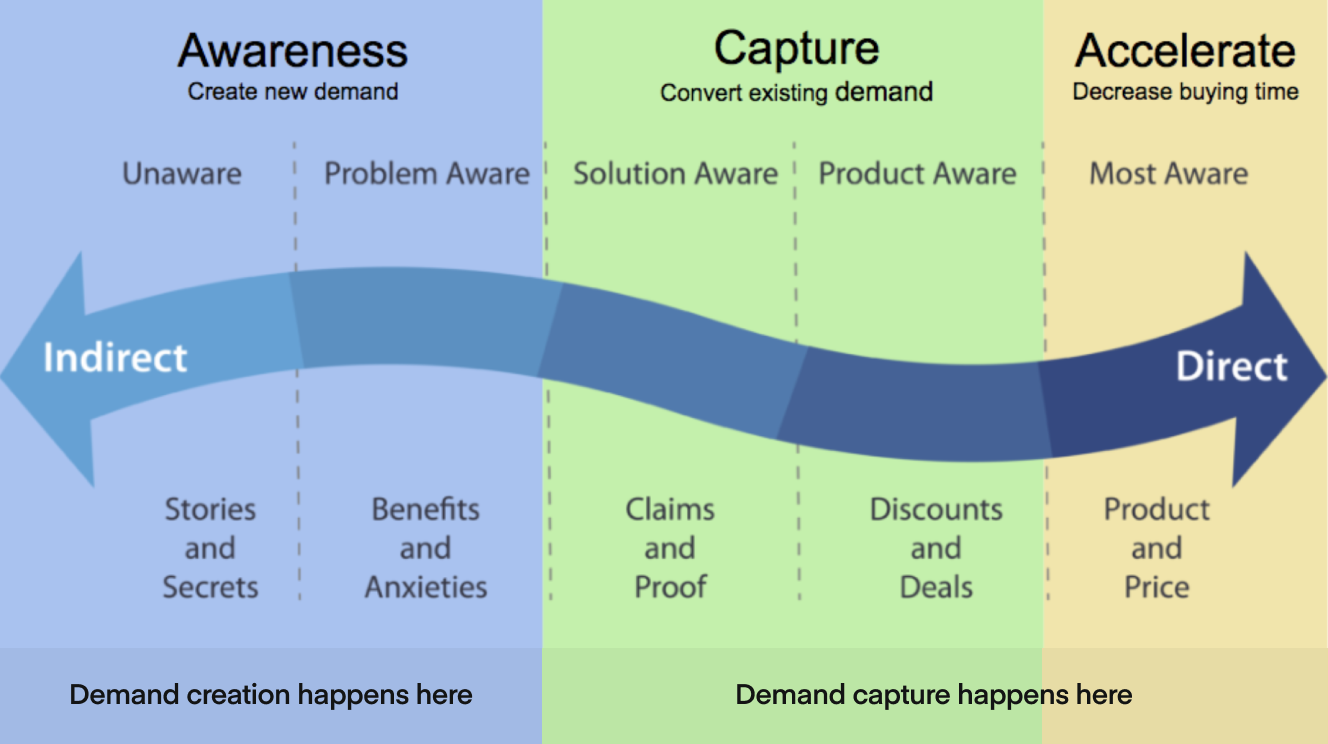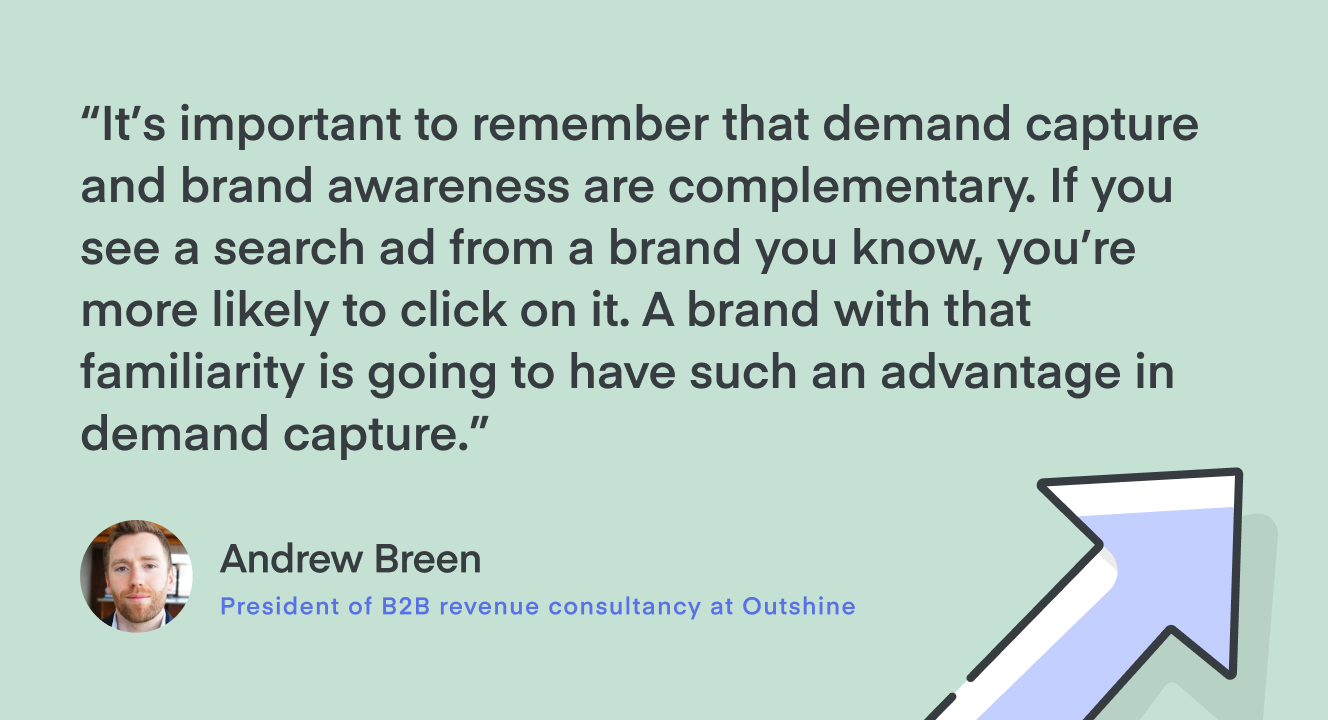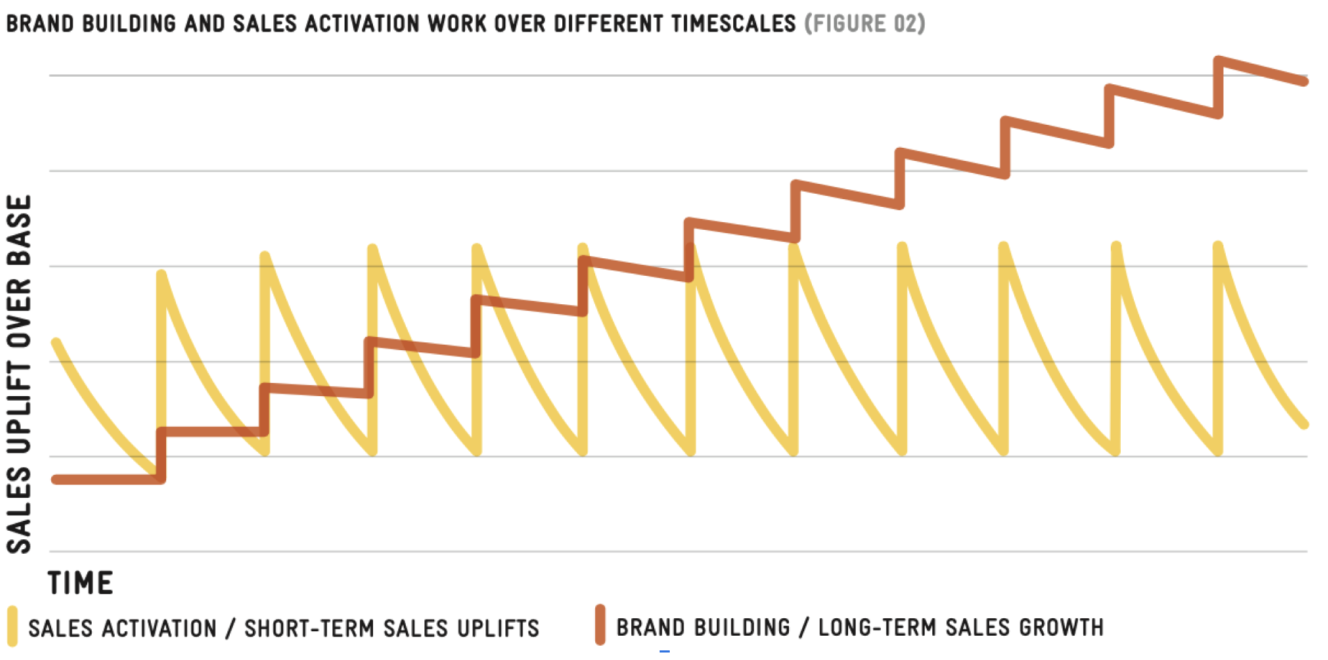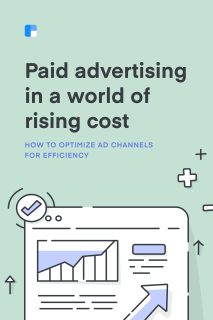Chapter 3
10 minutes
Adjusting your paid ads strategy
Over the last 10 years, demand generation professionals have rebelled against the “fluffy” brand marketing efforts of their predecessors.
Brand marketing is difficult to measure and slow to show results, so it’s no wonder that startups – which need quick growth – have prioritized lead gen campaigns. After all, they’re trackable and can produce instant leads in exchange for spend.
But today’s revenue-driven marketing teams are finding a balanced middle to create an optimal customer journey. They run direct response campaigns to get short-term growth, and also layer on awareness ad campaigns for long-term sustainability.
Running an awareness campaign is like planting seeds that will grow into a year-round supply of new blooms for your lead campaigns to harvest. At the top of the marketing funnel, awareness ads draw in your ideal customers who are unknown and unengaged, adding new people to your market. Then, direct response campaigns convert them.
It may seem counterintuitive to allocate ad budget to awareness when marketing costs are rising and you’re under pressure to show ROI. But combining the two approaches helps make ad programs more effective, cost-efficient, and durable for whatever the future holds.
Demand capture versus demand creation
Paid advertising campaigns typically have one of three purposes:
- Capture existing demand: Convert people who are already in the market for your product with direct response ads.
- Create new demand: Bring new people into your market with brand and awareness ads.
- Accelerate the buying process: Usher prospects down the pipeline as they talk to your sales team.
Most B2B marketers, especially at startups, are primarily concerned with the first type of campaign: conversion-oriented ads that promote a company’s products or services to people who already know they have a problem or a need.

We call that demand capture.
On the flip side, demand creation ads (or awareness/brand ads) target people who may not even be aware they have a problem that can be solved by a product. Brand ads work at the top of the funnel to raise “problem awareness” and make the market bigger.
 Source: Breakthrough Advertising by Eugene Schwarz
Source: Breakthrough Advertising by Eugene Schwarz
For example, a meditation app company might run awareness ads teaching that meditation improves sleep, increasing the market of people who believe meditation may help solve their sleep problems. Then, the company could capture that demand with conversion ads that encourage folks to download their specific app with a free trial.
Growing up: why startups add demand creation to their demand capture strategy
Early-stage companies that are under pressure to grow tend to over-index on demand generation marketing campaigns and under-index on brand ads.
And it works, at least at the start.
The problem is that once the demand capture exhausts most of the available demand, the paid ad program stops performing as well as it used to, and growth slows.
It’s like tapping a forest of maple trees for syrup and noticing the flow get slower and lighter over time. There may be more syrup to collect next season, but if you want to really multiply the amount of maple you have in the future, you might also want to start planting more trees.

This effect can also be seen in the first few weeks of any direct response campaign. Colin White, Clearbit’s Head of Demand Gen, says, “The first two weeks of a campaign are always higher volume – then they degrade and hit a baseline over time.”
To prevent campaigns from degrading, start boosting your long-term growth with awareness campaigns.
Demand loves awareness
The good news is that branding campaigns make direct response more effective. The two work together, not against each other.
Brand ads lift up the overall paid strategy
Combined, the two ad types create higher research intent. Google and Deloitte’s 2018 Brand to Demand study showed that when a B2B buyer recalled both a brand ad and a direct response ad, they were more likely to put that product on their shortlist.


Awareness advertising is all about priming the pump for future sales. Research by advertising experts Les Binet and Peter Field shows that brand-building ads have little immediate effect on sales results, but that, over time, they provide a greater sales uplift than short-term demand capture does.

Creating more options for lower-cost search keywords
Brand ads can also contribute to more cost-effective search advertising. Here’s a hypothetical example for a B2B payroll company.
A bottom-of-funnel keyword they might bid on, such as “compensation management software,” could cost an expensive $50 per click.
But if they move up the funnel and run brand ads, a new path opens up. A video campaign that targets HR professionals might only cost $0.08 cents a video. And if it prompts someone to google their brand, that click costs $3.
So, if the company drives 10 video ad views for 80 cents, and one person searches for their brand and clicks, that’s a $3.80 investment versus a $50 investment.
The awareness advertising campaign creates a new, less expensive arena for search ads. Before, the company was jostling for a low number of leads utilizing search engines to look for “compensation management software” (say, 170 searches per month). Now, they can also work higher up in the funnel, targeting all general HR-related topics (hypothetically, something more like 100 million weekly impressions).
The brand approach is certainly broader and less efficient than going after the detailed keyword, but it creates new options, and may be a way to influence CAC, especially over the long term.
Andrew says, "If you have the patience and the timescale to make the investments early on, they can really pay dividends because you don't have to only fight where that cost per click is incredibly expensive.”
If you believe brand ads are right for your company, here are some tips on asking your executive team for budget and making sure your strategy sticks.
Keys to success: Shifting to awareness advertising
Since brand advertising is a long-term investment that doesn’t show immediate return, it’s important that your stakeholders really understand why you’re doing it and what success looks like.
Generate true buy-in around the company
Spend time educating executives, the finance team, sales leaders, and any cross-functional collaborators:
- Tell the big-picture story. Awareness advertising brings new people into your market, allowing for continued success of demand capture campaigns and long-term growth.
- Show up with a concrete plan of how the budget will be used, to prevent perceptions of vague, fluffy marketing strategies.
- Ask for awareness budget when your demand capture campaigns are already hitting their goals. If you wait too long, performance on those campaigns will degrade as demand taps out, and it may be more difficult to justify a request for extra funds.
Create separate budgets for brand and conversion ad strategies
When your company is under pressure to hit short-term goals, it’s easy to cut off brand advertising and redirect all your resources toward demand generation efforts. Protect brand budget by keeping it entirely separate from conversion campaign budget.
Keep reporting separate as well. Because if you move 20% of your ad spend out of demand gen campaigns to awareness campaigns, that 20% will no longer be driving immediate leads and pipeline, making it appear as if the entire advertising program has slumped in the short term.
Use industry benchmarks and guardrails to set expectations
Set the expectation that brand ads need to be shown repeatedly to be effective. Three to seven exposures in a short period of time – say, two to four weeks – is considered the standard for breaking through the awareness barrier.

New products and complex products may need to be promoted more frequently to get their message across, and presented in multiple ways to help people understand. At Clearbit, our more complicated products need varied and repeated brand ads to get through to customers.
Define success in advance – and protect those goalposts
Being accountable to executives means being able to report on metrics, but it’s important to be clear with your stakeholders: pipeline and qualified leads are not the goals in awareness advertising.
Andrew says, “When someone asks how many leads and MQLs are coming from your awareness efforts, explain that that's not what you're trying to generate. Don’t even entertain it. You have to really hold that line.”
Instead, make sure that everyone is aligned on what awareness campaigns are really trying to achieve – and then continually reinforce that. “I have seen so many campaigns where the person who championed awareness leaves the company, no one's telling the message of why they were doing it, and it gets cut,” Andrew says.
You can measure the effectiveness of awareness ad campaigns in two ways: 1. Absolute performance __ (total impact, e.g., “is this working?”) 2. Relative performance (how did one campaign or channel perform compared to another?)
Absolute performance is more difficult to measure of the two, but it’s also more important for stakeholders. Some methods to measure it include:
- Lift in branded organic search volume: The increase in the number of people looking for your brand
- “How did you hear about us?”: Post-signup surveys, feedback from salespeople, and Gong recordings
- Other anecdotal evidence: Retweets, LinkedIn posts that mention your campaign, and using Clearbit Reveal to see which companies came to your website from awareness campaigns
A compelling way to show impact is to create a slide that compiles anecdotal evidence, like company logos of the most impressive website visitors and screenshots of LinkedIn posts. “Those marketing stories really get people excited,” Andrew says.
Absolute performance requires a long time to show lift, especially if you’re measuring with branded organic search, where even the most promising campaigns take a while. Zoom out and report on these efforts quarterly, rather than weekly or monthly.
Relative performance, on the other hand, is faster to measure. It helps you optimize and improve by comparing your work side by side: “Facebook is more efficient for us than LinkedIn;” “target audience A is better than audience B;” or “ad A is yielding better results than ad B.”
Examples of relative performance metrics and measurement include:
- Cost per engaged user (or ideal user): Spot an engaged user by measuring their time on site and/or using Clearbit to check whether they fit your ICP profile
- Brand lift surveys: Compare the lift produced by two different brand ad efforts
- Measure ICP traffic: See what campaigns your qualified users are coming from, with Clearbit Reveal and the Clearbit Weekly Visitor Report
For more awareness measurement tips from Andrew and Colin, check out their webinar, “The Evolution to Paid Awareness Advertising.”
The best way to ensure the health of your future demand gen ad campaigns is to look long-term and shift some ad budget to awareness advertising.
Awareness advertising brings more people into the market upstream, ensuring that there will be a constant supply of new attention for your demand gen campaigns to capture.
It doesn’t produce the same instant-satisfaction results your colleagues might be used to, so as a marketer, your job is to share the bigger story — the importance of investing in brand early — with your broader team. After that, you can sit back and wait for the rewards to come.

